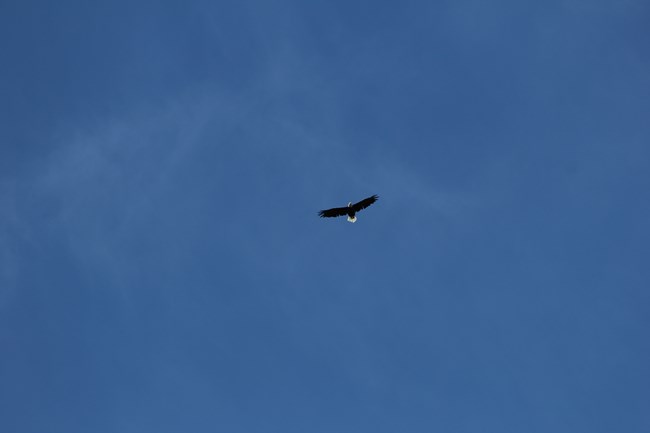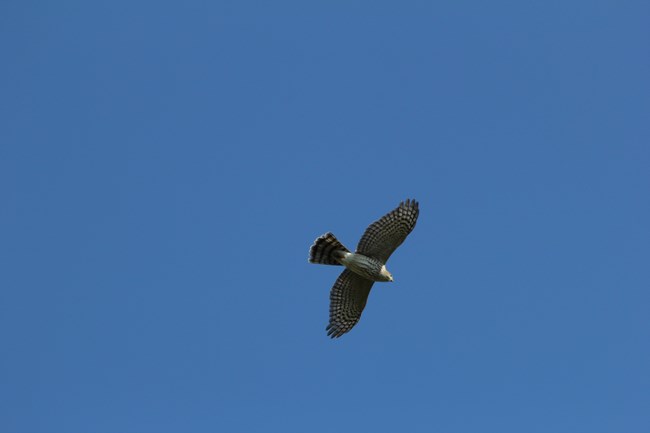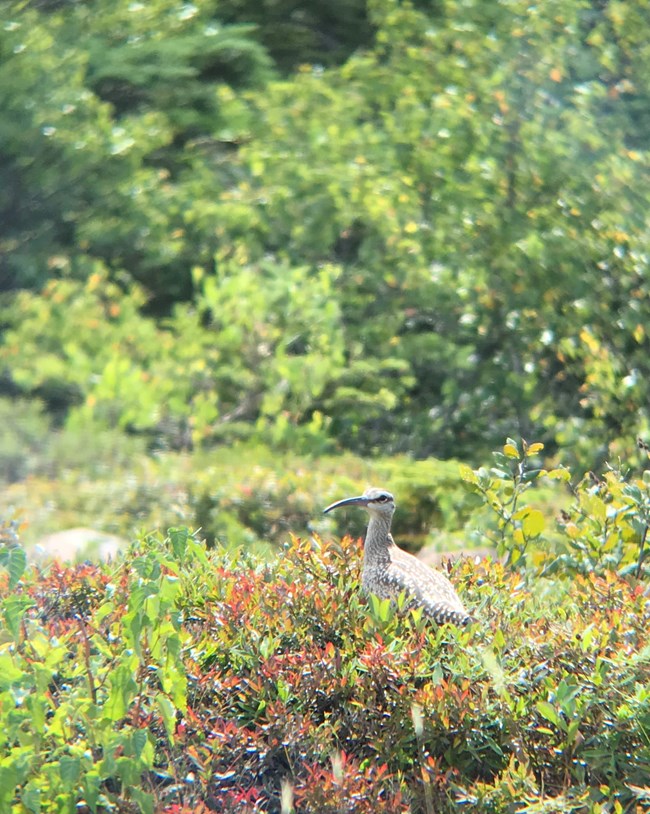Last updated: August 21, 2020
Article
Riding the Winds: Hawk Watch in Acadia National Park 2019

NPS/Mickey Shortt
September 21-28
This week of Hawk Watch began with a bang! On September 21st we counted 385 migrating raptors; 123 of these were American Kestrels. These colorful falcons typically appear at our Hawk Watch in early September, but they didn’t really begin to move until mid-to-late September this year. American Kestrels have experienced a steep population decline over the last 50 years. One factor in this decline is likely to be habitat loss. Some people have set up nest boxes for American Kestrels in an effort to assist them. Broad-winged Hawks are also on the move. These hawks in the genus Buteo are well-adapted to soar in open spaces, and soar they do – all the way down to Central and South America. Locations in Texas and Mexico will see hundreds of thousands of Broad-winged Hawks a day during the peak of their migration. Despite the excellent start to the week, hawk migration in Acadia fizzled out as the wind direction shifted or the view was obscured.
Migration Totals (9/21/19-9/28/19)
Turkey Vulture 8
Osprey 28
Bald Eagle 13
Northern Harrier 9
Sharp-shinned Hawk 196
Cooper’s Hawk 4
Broad-winged Hawk 141
American Kestrel 170
Merlin 15
Peregrine Falcon 7
Unknown Raptor 6

NPS/Patrick Kark
The week atop Cadillac Mountain was busy on the raptor front. We observed over 100 birds on three of the days at the Hawk Watch. As expected, large numbers of Sharp-shinned Hawks were counted this week, and we finally had more movement with American Kestrels. Of particular note was a sighting of a Northern Goshawk on September 17; this large accipiter flew over the Hawk Watch site at close range! Broad-winged Hawks were observed travelling in small kettles during the week as well. Dramatically higher numbers of Broad-winged Hawks were observed at other Hawk Watch sites that are more inland. Over thirty Bald Eagles were observed making their way across the mountain this week--this species' population continues to climb, and the Hawk Watch data bears witness to this increase.
Migration totals (9/15/19-9/20/19)
Turkey Vulture 15
Osprey 46
Bald Eagle 33
Northern Harrier 17
Sharp-shinned Hawk 351
Cooper's Hawk 5
Northern Goshawk 1
Broad-winged Hawk 141
Red-tailed Hawk 3
American Kestrel 100
Merlin 13
Peregrine Falcon 5
Unknown Accipiter 1
Unknown Falcon 2
Unknown Raptor 39
Total 772

NPS/Patrick Kark
Migration is well underway at the Cadillac Mountain Hawk Watch. Bad weather – including Hurricane Dorian’s march through the Northeast – and unfavorable winds led to below-average totals for much of the week, but there were a few good days in the midst of all the rain and fog. Our count exceeded 90 raptors two days this week: September 9th and September 13th. On September 13th, favorable winds and clear skies brought an impressive total of 135 raptors, the highest total at our Hawk Watch so far. Out of these, 67 were Sharp-shinned Hawks. These feisty raptors aren’t much bigger than a jay, but they are avid predators of songbirds. If you see a hawk eyeing your birdfeeder with menace that exceeds its small stature, it’s likely to be a Sharp-shinned. While some year-round populations exist, this species is largely migratory: Sharp-shinned Hawks summer in the northern US and Canada, with some birds traveling as far as Central and South America during the fall migration. Sharp-shinned Hawks are the most common birds at our Hawk Watch.
Migration Totals (9/8/19-9/14/19)
Turkey Vulture 19
Osprey 38
Bald Eagle 23
Northern Harrier 3
Sharp-shinned Hawk 204
Cooper’s Hawk 4
Broad-winged Hawk 21
American Kestrel 33
Merlin 6
Peregrine Falcon 3
Unknown Buteo 3
Unknown Raptor

Abbie Danner
September is here! More and more raptors are passing over the Cadillac Mountain Hawk Watch as we approach the peak of fall migration. Rain and fog dampened our numbers for the first week of the month, but the clearer days brought an impressive volume of migrating raptors. September 3rd, though foggy in the early morning, was a fine day for spotting Osprey: 9 of these unique, fish-eating raptors flew past our vantage point on Cadillac that day. Sunny weather and brisk winds from the northwest made September 5th an excellent day for watching hawks. Observers counted a total of 89 migrating birds, the highest daily total this year. North America’s smallest falcon, the American Kestrel, made its first appearance for the year this week. Though kestrels are the second most common species we see at our Hawk Watch, they don’t begin to migrate until early September. Four of these petite, colorful falcons were counted on Thursday, and more are sure to come. That’s all for this week’s Hawk Watch update – be sure to check in next week as we enter the peak time for fall migration!
Migration totals (9/1/19 to 9/7/19)
Turkey Vulture 15
Osprey 16
Bald Eagle 18
Northern Harrier 8
Sharp-shinned Hawk 84
Cooper’s Hawk 1
Broad-winged Hawk 5
Red-tailed Hawk 4
American Kestrel 4
Merlin 1
Unknown Buteo 3
Unknown Falcon 1
Unknown Raptor 15

NPS/Daniel McDermott
This week’s totals were fairly typical of the early migration season. Winds from the south thwarted our hopes of seeing a high volume of raptors – migrating raptors prefer north winds to give them an extra boost on their journey south for the winter. Even so, we’ve had some good looks at migrants such as diminutive Sharp-shinned Hawks, stately Northern Harriers, and powerful Bald Eagles. But we’re still early in the migration, and there is plenty more counting to do.
One interesting find this week was a Black Vulture (August 26), the first seen in the 25-year history of our Hawk Watch. This bird, which can be distinguished from a Turkey Vulture by its short tail and flapping flight, was circling over Frenchman Bay with a larger group of local Turkey Vultures. Black Vultures are considered a climate change indicator species: they are native to the southern US, but their range has expanded northward as temperatures warm.
There have also been a handful of Whimbrels sighted on Cadillac Mountain. These unique-looking shorebirds are normally spotted along the coastline, but they have ventured to the peaks in Acadia to forage for blueberries during their migration.
Migration Totals (8/25/19 to 8/31/19)
Turkey Vulture 10
Osprey 4
Bald Eagle 3
Northern Harrier 4
Sharp-shinned Hawk 21
Cooper’s Hawk 1
Broad-winged Hawk 1
Red-tailed Hawk 1
Unknown Buteo 2
Unknown Raptor 4
Total: 47
